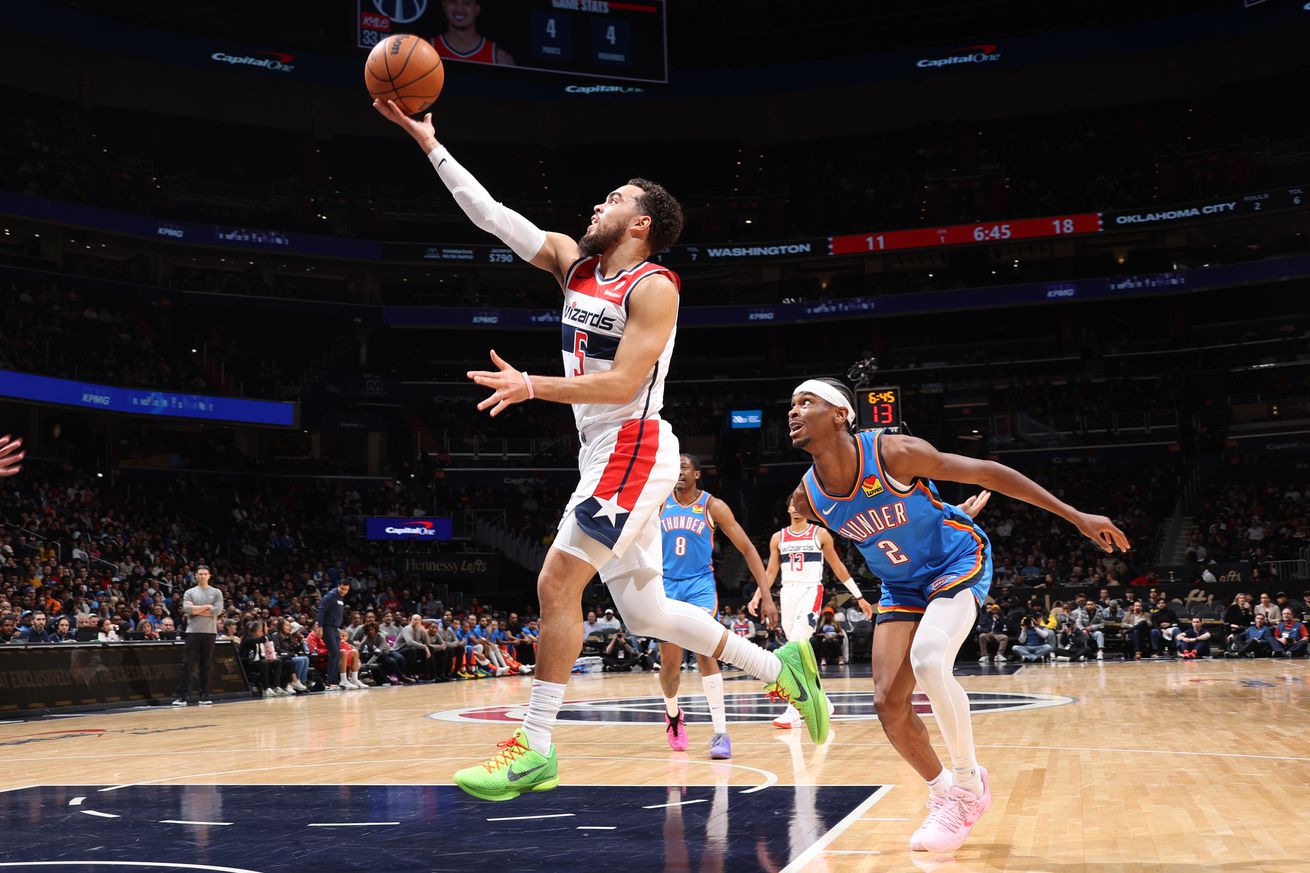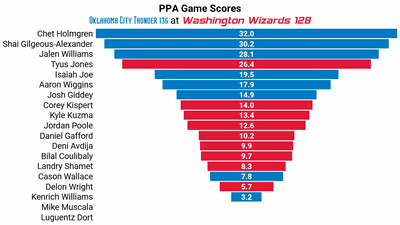
Stats, analysis, commentary.
No surprises Monday night in the Wizards matchup with the Oklahoma City Thunder, except maybe that there was no garbage time. The Thunder are a much better team, but Washington stayed in contact, never trailing by more than 13, getting as close as three late in the third quarter, before finally succumbing by 11.
As makes sense for teams at different ends of the NBA rebuilding continuum, Oklahoma City is significantly more talented. Illustration: Jalen Williams would be Washington’s best player by a lot. He’s third best on Oklahoma City.
Last night’s contest ultimately came down to making shots. The Wizards did pretty well — a 57.9% effective field goal percentage, well above their 54.8% average. Unfortunately, the Thunder shot 67.0%, the third best mark of the season against the Wizards, and fifth best for Oklahoma City.
The Wizards defense was up to its usual standards, which is to say it gave up an abundance of wide-open threes to excellent shooters, as well as an array of layup line at-rim attempts. Washington’s point of attack defense was feeble and led to several dunks when big man Daniel Gafford was drawn off his man to pick up a driver.
Head coach Wes Unseld Jr. tried several different defensive concepts to see if anything would slow down the Thunder attack. They all failed.
At least it wasn’t another blowout.
Musings & Observations
- One possession rankled. The Wizards missed a shot, and Gafford and Kyle Kuzma hit the offensive glass, chasing the rebound. They failed to get the ball, and the Thunder advanced the ball with three offensive players against three Wizards defenders. While Kuzma and Gafford jogged back on defense, Chet Holmgren sprinted up court to give his team a numbers advantage…and got a fast break layup and drew a foul.
- Yet another superbly efficient offensive game from Tyus Jones — 18 points on 10 shots, 9 assists to 2 turnovers. He shot 3-5 from three to raise his season average from deep to 43.9%. On defense, he’s small and gets beat on dribble penetration regularly, but he did contribute three steals.
- Corey Kispert made shots — 4-5 from the floor, 3-4 from three. He managed 1 rebound and 2 assists in 18 minutes.
- Kuzma’s glory stats look good — 22 points, 15 rebounds, 5 assists. If you want to think he played well, pay no attention to the 10-24 shooting, 0-5 from three-point range, and 2 turnovers. In a game where Oklahoma City’s offensive rating (points per possession x 100) was 134, and Washington’s was 126, Kuzma’s was a dismal 98.
- Jordan Poole made some shots, produced five assists to one turnover, and therefore had one of his better games in a Wizards uniform. He was at his best in the third quarter when he scored 15 points on 6-9 shooting, including 4-6 from three.
- Fun fact: the Wizards starting backcourt had zero rebounds in 60 minutes of playing time.
- Fun fact: the only players in last night’s game to not get a single rebound were Jones and Poole.
- Gafford had a rough time against a center as mobile and skilled as Holmgren. He managed 9 points and 9 rebounds and got roasted trying to handle rampant dribble penetration while Holmgren feasted on open threes, at-rim bunnies, and made plays for teammates.
- Deni Avdija produced an efficient offensive game despite four turnovers by hitting making shots (5-8 from the floor, 2-3 from deep), getting to the free throw line (5-6), and pushing the ball in transition. Thunder defenders demonstrated awareness of Avdija’s challenges going left, and they forced turnovers by overplaying to his right.
- Avdija had a handful of impressive defensive possessions early on Shai Gilgeous-Alexander. As indicated by SGA’s 32 points on 17 shots, Washington struggled to find success defending him.
- Bilal Coulibaly was just 1-4 from the floor, though he did come up with 5 rebounds, 3 assists and 2 blocks in 25 minutes. It was another ultra-low usage game from him — just 9.1% usage rate.
Four Factors
Below are the four factors that decide wins and losses in basketball — shooting (efg), rebounding (offensive rebounds), ball handling (turnovers), fouling (free throws made).
Stats & Metrics
Below are a few performance metrics, including the Player Production Average (PPA) Game Score. PPA is my overall production metric, which credits players for things they do that help a team win (scoring, rebounding, playmaking, defending) and dings them for things that hurt (missed shots, turnovers, bad defense, fouls).
Game Score (GmSC) converts individual production into points on the scoreboard. The scale is the same as points and reflects each player’s total contributions for the game. The lowest possible GmSC is zero.
PPA is a per possession metric designed for larger data sets. In small sample sizes, the numbers can get weird. In PPA, 100 is average, higher is better and replacement level is 45. For a single game, replacement level isn’t much use, and I reiterate the caution about small samples sometimes producing weird results.
POSS is the number of possessions each player was on the floor in this game.
ORTG = offensive rating, which is points produced per individual possessions x 100. League average last season was 114.8. Points produced is not the same as points scored. It includes the value of assists and offensive rebounds, as well as sharing credit when receiving an assist.
USG = offensive usage rate. Average is 20%.
ORTG and USG are versions of stats created by former Wizards assistant coach Dean Oliver and modified by me. ORTG is an efficiency measure that accounts for the value of shooting, offensive rebounds, assists and turnovers. USG includes shooting from the floor and free throw line, offensive rebounds, assists and turnovers.
+PTS = “Plus Points” is a measure of the points gained or lost by each player based on their efficiency in this game compared to league average efficiency on the same number of possessions. A player with an offensive rating (points produced per possession x 100) of 100 who uses 20 possessions would produce 20 points. If the league average efficiency is 114, the league — on average — would produced 22.8 points in the same 20 possessions. So, the player in this hypothetical would have a +PTS score of -2.8.

